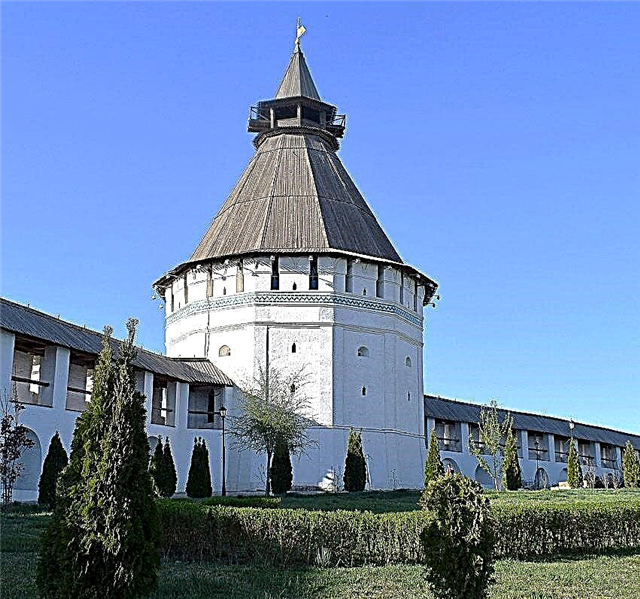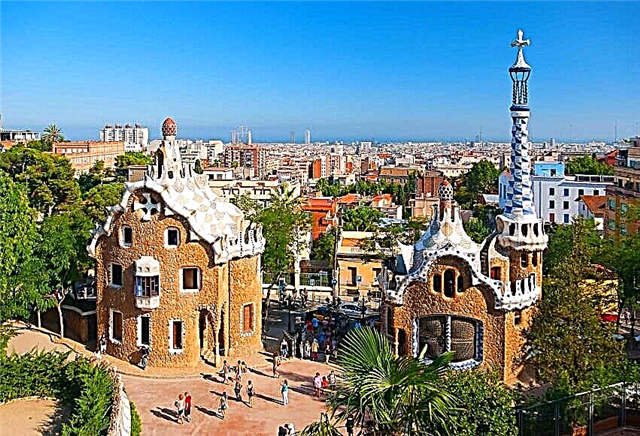The Astrakhan Kremlin, built on a high Hare Island, surrounded on all sides by rivers: the Volga, Kutuma and Tsarev, served as an outpost that protected the southern borders of the Moscow State from enemy invasions from the day of its foundation. Closed by the Cossack Erik in a single water ring, it became an obstacle to the invaders who tried to take Astrakhan.
Behind the powerful fortress walls, 22 unique historical and cultural objects of Russian defense, church and civil architecture of the 16th - early 20th centuries have been preserved to this day, which received the status of federal attractions under state protection.
History of the Astrakhan Kremlin
The construction of the Kremlin defensive structure began in the middle of the 16th century according to the design of the engineer Vyrodkov with a double wooden fortress wall. The wall openings were filled with earth and large stones. The fortress fence in its layout was in the form of a right-angled triangle with apex directed to the south-west. Four years after the start of construction, a tower and an entrance gate appeared in the Kremlin.
After the accession of new lands to the Russian state and gaining access to the Caspian Sea, the importance of the fortress increased. During the reign of Ivan the Terrible, the construction of a stone fortress began, which ended with Boris Godunov. A complex of fortifications, church and civil structures has grown around the tower.

Prechistenskaya bell tower
The entrance Prechistenskaya Gate stands out against the background of the skies with a snow-white four-tiered bell tower 80 meters high. The belfry, built in the first decade of the 18th century, was rebuilt four times due to the constant slope caused by soil subsidence. At the end of the 19th century, the tilt was so obvious that the townspeople called it “the local Leaning Tower of Pisa”.

The year 1910 was a new birth for the unique bell tower thanks to the architect Karyagin, who built it in the old Russian classical style of architecture. In 1912, the belfry was decorated with electric musical chimes, emitting a melodic chime every 15 minutes, and at 12:00 and 18:00 - playing the solemn melody of Mikhail Glinka "Glory". Such Prechistenskaya bell tower, shown in the photo of numerous tourist avenues, we see today.


Assumption Cathedral
Near the famous bell tower stands the Cathedral of the Assumption of the Most Holy Theotokos, which has been under construction since 1699 for 12 years. The majestic two-tiered church, built in the traditions of the church Moscow baroque, rises, sparkling with gold five domes crowned with crosses. The snow-white facades delight with the art of openwork stone carving.
The temple of the lower tier, dedicated to the Meeting of the Icon of the Vladimir Mother of God, is lower, served as the burial vault of high-status clergy. It contains crayfish with the relics of saints: Theodosius and Metropolitan Joseph, who was killed during the uprising of Stepan Razin, the kings of Georgia - Vakhtang VI and Teimuraz II are buried.



The Assumption Church, located on the upper tier, is a tall building intended for divine services. Marble walls, two-tier windows, columns, a luxurious iconostasis, ceiling frescoes of the Byzantine style and Palekh paintings of domed drums - this is how the interior of the temple appears before visitors.
Trinity Cathedral and Cyril Chapel
The church, built in honor of the Life-Giving Trinity in 1576 in a men's monastery, is one of the oldest buildings in the Kremlin. By the beginning of the 17th century, the wooden church was replaced by a stone cathedral, which was rebuilt several times over three centuries after fires and wars.
Today Trinity Cathedral is an ensemble of three churches: Sretenskaya, Vvedenskaya and Trinity, located on the same basement with two refectory adjacent to them. The cathedral contains the graves of the first Astrakhan bishops. According to legend, near the outer northern side of the temple lie the remains of 441 residents of Astrakhan, mortally tortured by rebels Stepan Razin.
The facades of the Trinity Cathedral have been mostly restored and brought to their original appearance. In 2018, restoration work continues on finishing inside the temple.
We advise you to look at the Novgorod Kremlin.
Near the cathedral is the Cyril Chapel, where the first abbot of the Trinity Monastery, Cyril, is buried.
Gate Church of St. Nicholas the Wonderworker
The gate church, named after the saint, according to the ancient Christian tradition, served as a guardian of the city and its inhabitants. The construction of the Nikolsky Gate in the northern tower and the gateway church of St. Nicholas the Wonderworker was carried out simultaneously with the construction of the stone Astrakhan Kremlin.
The gates led to the pier where various ships were moored, including the ship of Peter I, who visited the Kremlin at the beginning of the 18th century. In 1738 the dilapidated gate church was rebuilt in the style typical of the Russian Middle Ages. Powerful white-stone church walls, covered with a tent, crowned with a small onion dome, appeared over the stone arches of the passage gate.
Kremlin towers
The Astrakhan Kremlin was protected by a well-thought-out system of 8 towers, interconnected by passages: blind, located in the wall, angular, protruding from the wall and travel, located in the gate. The tower walls were up to 3.5 meters thick. Their jagged vaults were crowned with wooden tents, which housed watchtowers. Each of the towers performed its own task when defending the fortress:
- The Bishop's corner deaf tower can be seen on the left side of the main Kremlin gate - the Prechistenskaya gate tower. The tower walls in their current form were built during the reconstruction of 1828. The bishop's tower was named back in 1602, when the Astrakhan diocese was formed, to which land was allocated in the southeastern part of the Kremlin. A two-story stone residence of the Metropolitan was built at the bishop's courtyard - a building with chambers and a house church. As a result of rebuilding, the bishop's house became four-story. From the original building on the facade, three ancient tiles have survived, which depict: Alexander the Great with a saber, saddled a horse, a lion guarding the imperial palace and the image of a winged monster.

- Zhitnaya blank tower, located in the southern side of the fortress, has been preserved in its original form thanks to the lake and buildings from different sides. The name of the tower was given to the Zhitny Dvor - a fenced-in place near the southern wall, where there were outbuildings for storing grain and other food.


- The deaf fortification structure - the Crimean Tower, got its name from its location opposite the Crimean Way, from which the Krymchaks attacked. This powerful structure was rebuilt several times due to the damage it received when repelling enemy attacks.

- The Red Gate Tower is located in the northwestern part of the Kremlin wall above the high steep bank of the Volga. It differs from others in the design of a 12-sided vaulted ceiling, which gave an advantage in all-round defense from the enemy. According to the surviving written evidence, the cannonballs from this tower flew 200-300 meters, and from the patrol platform, the right bank of the Volga was monitored, from where enemies and caravans with food arriving along the river approached. The tower got its name due to its beautiful elegant appearance. After the restoration of 1958, a museum exposition was deployed in it, where exhibits telling about who built the Kremlin, rare old photographs with a description of the Kremlin sights, rare maps and pictures of old Astrakhan are presented.

- The northeastern corner of the fortress wall is marked by the Artillery Tower, adjoining to it the former Zelein (gunpowder) yard. A preserved medieval powder magazine is of interest in the courtyard. The tower performed not only the defensive function of the Kremlin, but in the 17th century, during the peasant war under the leadership of Stepan Razin, it was a place of imprisonment for nobles and officials, where interrogations were carried out using torture and murder. Therefore, the people called it the Torture Tower. Ironically, after the suppression of Razin's uprising by the tsarist government, the rebels suffered the same fate in the tower. The Zeleyny Dvor Square has become a place where ancient cannons are displayed, and inside the tower there is an exposition introducing visitors to how corporal punishment was carried out in the 16th-18th centuries in the Moscow kingdom. Descending under the arches of the Powder Magazine, visitors to the interactive exhibition will gain interesting knowledge about the origin and improvement of firearms.


The Mystery of the Water Gate
During the reconstruction of 1970 a section of the fortress wall from Nikolsky to the Red Gate, a secret underground passage was found under the foundation of the dilapidated former infirmary for soldiers. The corridor dug underground was lined with bricks. The exit to the outside was closed by a heavy metal grate that rises and falls as the mechanical drum rotates. The popular legend about the underground passage to the Volga was confirmed. The hiding place under the mountain was a water gate that served as the only way to replenish water supplies during the siege of the fortress.
Guardhouse building
The first guardhouse was built at the beginning of the 18th century during the reign of Peter I. The guardhouse, which appears to the eyes of the Kremlin's visitors today, dates back to 1808. It was built on the site of the old guardhouse for the garrison guard. Now, excursions are conducted around the guardhouse, during which visitors will learn interesting details of the life and service of soldiers in the 19th century, examine the interior of the officer's living room and the office of the garrison commander, and visit the premises for prisoners.
Kremlin Museum
The opening of the museum complex-reserve "Astrakhan Kremlin" for visitors was 1974. The restored sights include: a museum of ethnography with a unique collection and many exhibitions revealing the history of the Kremlin, Astrakhan and Russia from the Middle Ages to the present day. The former armory is home to an exhibition center that hosts exhibitions of famous artists, wax figures and scientific achievements. Every year the Astrakhan Opera House shows the opera "Boris Godunov" against the background of historical objects serving as scenery in the open air.


Each of the buildings of the Kremlin has its own exciting legends and secrets, which are interestingly told by the guides. From the observation tower of the Red Gate, amazing views open up and magnificent photographs are obtained that will remind you of Astrakhan and its pearl - the Kremlin.

Where is the Astrakhan Kremlin, opening hours and how to get there
The address of the museum complex: Astrakhan, Trediakovskogo street, 2.
Convenient working hours from 7:00 to 20:00 allow you to stay in the Kremlin all day long. It is not difficult to get to the unique sight. Bus # 30, trolleybus # 2 and many minibuses go near the railway station, next to which the bus station is located. You should go to Lenin Square or October Square. They are just a stone's throw from the Kremlin, guided by the Prechistenskaya bell tower.
The beauty of the white-stone masterpieces of Russian architecture, like a magnet, attracts numerous flows of tourists to the Astrakhan Kremlin. The feeling of unusual energy, which carries over to the times of Ancient Russia, does not leave here, causing the desire to return to Astrakhan again.
















